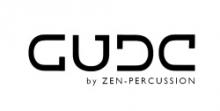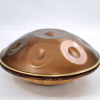
We would like to say a few words about such class of musical instruments as tongue drums. Zen Percussion company produces and sells various musical instruments, but our main products (and passion :) ) are steel tongue drums. Now we can proudly notice that the name of our most popular instrument - GUDA Drum has already become a household name and can designate a whole range of instruments.
So, we would like to look back in history and tell our visitors briefly about tongue drums and history of the creation of Guda.
The surge in popularity of steel drums came not so long ago, especially at the beginning of the 21st century. That was preceded by one important event. In 1999, such a wonderful instrument as Hang Drum was presented to the public. Its popularity led to the creation of a wide range of instruments - Handpans. The amazing sound and unusual look of these instruments could not leave anyone untouched. However, due to complexity of production (and as a consequence - high cost and rarity), not everyone can afford these instruments. Therefore, some wise heads proposed their solution to the problem - replacing sophisticated handpans with simpler tongue drums.
We hasten to clarify - handpans is by no means an ancestor of steel drums. Tongue drums in one form or another existed long before the emergence of handpans. One of the oldest instruments in the world is Slit African drums that can be attributed to the ancestors of tongue drums. You can also notice a certain similarity between the steel tongue drum and such ancient instrument as Kalimba (kalimba, mbira), and the jaw harps. Modern wooden tongue drums have also originated a long time ago, they can claim the role of the ancestors of tongue drums as well.
A bit of theory:
According to the musical classification, a tank drum, like the Swiss Hang, as well as all the analogs of the Hang - Handpans and Pantams, belong to the class of idiophones. It means that the source of sound is case itself, "body" of the instrument or part of it.
Idiophones (from Greek ιδιος - their + Greek φωνη - sound) do not require preliminary manipulation for playing sounds, such as tension or compression. For example, tuning up stringed instruments, or necessity to tighten the drumheads. Therefore, a tank drum is not a drum. As well as Hang, in general)
Relying on archaeological finds, it can be said that idiophones are one of the oldest kinds of musical instruments on our planet, not counting the human voice. These instruments are very common, they are present in cultures all over the world. Archaic human made such instruments of everything that was at hand - wood, metal, ceramics, bone and glass.
Steel tongue drums in the 21st century
The steel tongue drum had several predecessors, most notably the Whale Drum in 1990 by Jim Doble and the Tambiro by Felle Vega. The first videos with these interesting instruments appear in the area of 2005 - 2007, when the famous percussionist Felle Vega presented his musical invention named "Tambiro" - a propane tank with petals cut on the side.
But was he the pioneer here? Probably he was inspired by African and South American slit and petal wooden drums - the oldest percussion instruments on the Earth. Or maybe by their modern analogs - wooden Tongue Drums?
Perhaps it was these drums that led him to the idea of cutting the petals on a side of the tank, as Africans do, burning slits and petals in the trunk of a hollow log. Also, the role of "inspirers" of the inventor could play the Vargan or African "mini pianoforte" - Kalimba, which also has tongues and a resonator, amplifying sound and vibrations.
A little later, the famous inventor of instruments Denis Havlena slightly improved the invention of Felle, placing the petals on the bottom of the tank. It was much more conveniently for playing and allowed to place around a dozen notes. Simplicity in mastering, unusual design, magic sound - all these factors influenced on the great popularity of tongue drums all over the world.
The origin of the Guda Drum
However, let's return to our instrument - Guda Tongue Drum. Our instrument is the ideological successor of both early metal tongue drums and handpans. If from the first ones he inherited his name and the physics of sound reproduction, then he took the form factor, the manufacturing technology after handpans, and also one very important element - the presence of pronounced overtones in sound. Our instrument was born in 2013, and its main features, which allocated further Guda Drum as a distinct class, were:
- The form factor of handpans, presence of the sound hole in the upper or lower part. Making tongue drum from two hemispheres followed by gluing on special technology.
- The presence of octave overtones in sound - this feature not only decorates the sound and makes it brighter and louder. With Guda you can play 2 notes on one petal.
- Appearance - we paid much attention to the exterior of Guda Drum. The Guda`s surface is carefully processed and then decorated with hand engraving. As an additional decoration and functional element, we use decorative braiding around the edge of the instrument.
In conclusion, I would like to say that we are very grateful to all people who made such different and wonderful musical instruments and inspired us to create our own. And special thanks for all our customers whose reviews and satisfaction have always been our greatest reward and motivation for us
Max Plakhtin and Alex Lozhkin for Guda Drum






